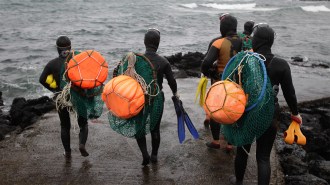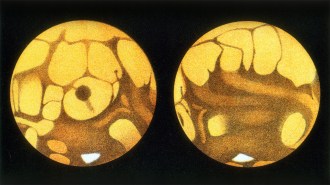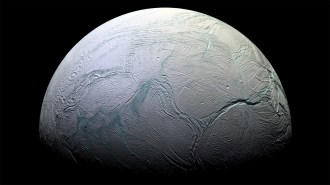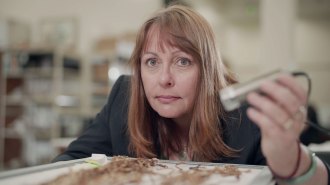All Stories
-
 Science & Society
Science & SocietyScientists are people too, a new book reminds readers
The Shape of Wonder humanizes scientists by demystifying the scientific process and showing the personal side of researchers.
By Karen Kwon -
 Humans
HumansThese female divers spend more time underwater than any other humans
At an average age of 70, these women divers in South Korea still forage in the sea up to 10 hours a day and spend more than half of that time underwater.
-
 Animals
AnimalsStreaked shearwaters poop only while flying over the ocean
In-flight defecation may help the birds stay away from feces that can contain pathogens such as bird flu while also fertilizing the ocean.
-
 Space
SpaceAstronauts need oxygen. Magnets could help
Adding a magnet could simplify the process of producing oxygen in space, making a crewed mission to Mars more feasible.
-
 Archaeology
ArchaeologyAncient hominids made long road trips to collect stone for tools
A Kenyan site shows early hominids transported stone 13 kilometers for toolmaking as early as 2.6 million years ago.
By Bruce Bower -
 Astronomy
AstronomyThe oldest known black hole formed more than 13.3 billion years ago
The Webb telescope found that a far-off little red dot is the oldest known black hole, shrouded by gas that could help explain the ruby color.
-

Cold Cuts Crossword
Solve our latest interactive crossword. We'll publish science-themed crosswords and math puzzles on alternating months.
By Rachel Fabi -
 Animals
AnimalsA single protein makes lovesick flies spill their guts
Producing a male-specific protein in digestion-related neurons may have led to the evolution of an odd “romantic” barfing behavior in one species of fruit flies.
-
 Planetary Science
Planetary ScienceHow alien ‘canals’ sparked debate over life on Mars
In The Martians, journalist David Baron recounts scientific and public debate over purported intelligent life on the Red Planet.
-
 Planetary Science
Planetary ScienceCosmic rays could, in theory, sustain life on other worlds
The hypothesis could extend the search for extraterrestrial life to include frigid planets with thin atmospheres and underground water.
-
 Environment
EnvironmentA glacier burst, flooding Juneau. Again. This one broke records
A warming climate is behind growing floods of glacier meltwater in Alaska’s capital. Scientists say it’s the new normal.
By Douglas Fox -
 Anthropology
AnthropologyA 104-centimeter-long hair could rewrite recordkeeping in Inca society
Analysis of the hair used in a knotted device reveals the owner’s simple diet. That suggests commoners, not just the elite, kept records in Inca society.